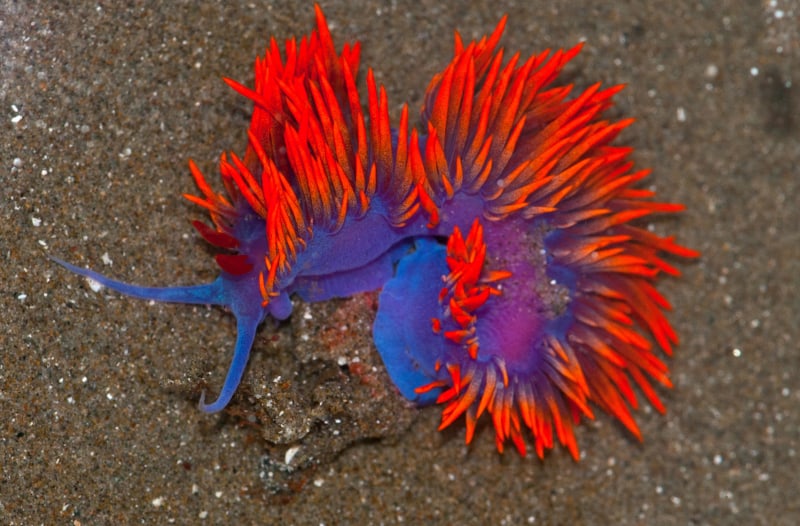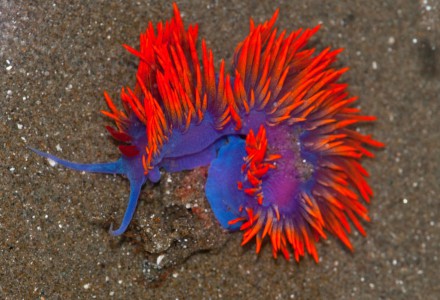
Spanish Shawl Facts
- Amazingly, the appealing term of Spanish Shawl serves as the generally accepted common name for an especially colorful type of sea slug. Its scientific name, however, remains that of the tongue-twisting term of Flabellinopsis iodinea.
- Regardless of which of these terms one uses to refer to it, though, one fact remains unchallenged. That has to do with the appearance of the awesome creature. This fabulous species represents one of the most brilliant of its kind known to mankind.
- This truly amazing variety of marine gastropod mollusk further conceals an incredible attribute. That holds true due to the fact that, unlike most creatures, this little beauty actually evolved as entirely hermaphroditic in its nature.
- In this manner, evolution provided this marvel of Nature with an advantage over many other creatures around the world. The delicate-seeming Spanish Shawl appears to also have population base that’s both sufficient and relatively stable.
- The IUCN, therefore, currently has no listing for it on the organization’s Red List of Threatened Species. Nonetheless, it must be considered to be facing potential threats to its existence. Likely, the greatest of these perils consists of climate change.
Related Articles
Spanish Shawl Physical Description
To be certain, without doubt, the amazing Spanish Shawl truly mesmerizes those fortunate enough to see it. The species nonetheless does not do so due to sheer physical size. That’s obvious because of the fact that it remains a physically diminutive creature.
This even holds true in relation to its many related species around the globe. This member of its genus, however, doesn’t stand out because of its size. It does so because of the fact that, unlike many others, this nudibranch shows no sign of sexual dimorphism.
As a result, the mature individuals of both genders achieve approximately the same measurements. This results in the attainment of an average body length of roughly 2.75 in (7 cm). That actually ranks it as slightly smaller than average for its kind.
Plus, mature specimens of both sexes of the Spanish Shawl display the same patterns of color. In point of fact, this consists of brilliant shades of three specific colors. Those include a bright purple body, a bright neon orange cerata, and usually scarlet colored rhinophores.
- Kingdom: Animalia
- Phylum: Mollusca
- Class: Gastropoda
- Order: Aeolidioidea
- Family: Flabellinidae
- Genus: Flabellinopsis
- Species: F. iodinea
Spanish Shawl Distribution, Habitat, and Ecology
Quite unfortunately, the gorgeous Spanish Shawl presently inhabits a comparatively restricted range of habitation. That’s due to the most regrettable fact that the awesome gastropod only appears along the west coast of North America.
More precisely, though, scattered populations of this small but magnificent creature have been sighted over much of that range. This includes as far north as British Columbia, in the country of Canada, to as far south as the Baja region, in the country of Mexico.
However, even within this highly limited zone of habitation, it stays concentrated. The stunning animal has very specific requirements for where it lives. This remains true since this beautiful creature also prefers to inhabit regions of relatively shallow water.
These specific areas, though, most typically occur very near the shore, wherever they appear. Hence, individuals of this species occur from intertidal areas to depths of as much as 130 ft (39.6 m). Most nevertheless prefer shallower depths.
Much like its roughly 3,000 related species, the awesome Spanish Shawl also evolved as a carnivore. In its case, though, its prey principally consists of such creatures as anemones. It nonetheless also likes to consume the eggs of other mollusks.
Meanwhile, its own primary predator might surprise many of you. In point of fact, this is actually another nudibranch, the Navanax. Finally, although the species did surprisingly evolve as fully hermaphroditic, self-fertilization rarely happens.
Species Sharing Its Range
Check out our other articles on Marbled Cat, Cecropia Moth, Marine Iguana, Whitehaven Beach, 6 Mysterious Natural Phenomena, Crown-of-thorns starfish, Pallid Bat

